Hartbeespoort, nestled at the foot of the Magaliesberg mountain range in South Africa, is a serene getaway renowned for its breathtaking scenery and plethora of activities suited for nature lovers and adventure seekers alike.
The area flourishes with rich wildlife, including the Hartbeespoort Dam, a prime spot for water sports and fishing. Cultural highlights include local craft markets and the Welwitschia Country Market, offering exquisite handmade items, as well as the nearby Lesedi Cultural Village, providing immersive Zulu, Xhosa, Pedi, Basotho, and Ndebele experiences.
Before visiting, check local guides for the availability of activities around Hartbeespoort Dam, as seasonal variations may affect what’s accessible, ensuring a fulfilling trip.
Embrace the chance to explore beyond the usual; a visit to the nearby Cradle of Humankind, one of the world’s richest hominid fossil sites, is highly recommended.
Top things to do & see in Hartbeespoort
Select the following sights and activities to discover best tickets and tours available in Hartbeespoort.
Hartbeespoort: A Serene Escape from the Bustle
| Country | South Africa |
| Time in Hartbeespoort | GMT+2 |
| Language spoken | Afrikaans |
| Population | 22,349 (Worldpopulationreview.com) |
| Currency | South African Rand (ZAR, R) |
| Airports |
|
Hartbeespoort, nestled at the foot of the Magaliesberg mountain range in South Africa, is a small resort town famous for its panoramic vistas and the Hartbeespoort Dam. The town, affectionately referred to as “Harties,” is a hub for outdoor enthusiasts and families alike, offering an array of leisure activities. Given its proximity to major South African cities like Johannesburg and Pretoria, it serves as a popular weekend getaway for many urban dwellers.
In addition to the natural scenery, Hartbeespoort is home to several points of interest. The Hartbeespoort Dam itself is a focal point in the area, providing opportunities for water sports and fishing. Surrounding the dam, visitors can explore numerous markets, animal sanctuaries, and gardens. Art lovers can enjoy the vibrant local art scene with galleries and craft markets showcasing traditional and contemporary works.
The region’s rich history is visible in its architecture and the various monuments that stand testament to its multifaceted past. Cultural heritage sites offer a glimpse into the life of earlier settlers, while also celebrating the indigenous communities that have lived in the area for centuries.
Outdoor activities in Hartbeespoort include hot air ballooning, hiking through the Magaliesberg Mountains, zip-lining, and golfing at several well-maintained courses. Additionally, the town’s proximity to Pilanesberg National Park and the Cradle of Humankind makes it a strategic point for tourists interested in safaris and exploring human history.
Overall, Hartbeespoort offers a blend of relaxation, adventure, and culture, making it a remarkable destination for travelers seeking a diverse South African experience.
Where is Hartbeespoort?
Located in the North West Province of South Africa, near the cities of Pretoria and Johannesburg.
Distances:
| Route | Distance by car | Time by car |
|---|---|---|
| Johannesburg to Hartbeespoort | 46 miles (74 km) | 1 hour |
| Pretoria to Hartbeespoort | 36 miles (58 km) | 45 minutes |
What is Hartbeespoortfamous for?
Hartbeespoort is renowned for its scenic Hartbeespoort Dam, thriving outdoor activities, and its role as a tranquil retreat from city life, offering both adventure and relaxation.
History
Early Settlements and Pre-colonial Period (Pre-1800)
Before the colonial footprint had touched its fertile valleys, Hartbeespoort in South Africa was primarily inhabited by hunter-gatherer communities. These early groups, termed as San or Bushmen by subsequent settlers, had a minimalistic and nomadic lifestyle, reaping the benefits of the rich biodiversity of the region. Their rock paintings can still be found in some parts of the surrounding hills, illustrating their deep connection with the land and its creatures.
Colonial Era and Development (1800-1900)
The 1800s marked a significant shift for Hartbeespoort as it began to see an influx of European settlers, primarily of Dutch descent, seeking to capitalize on its agricultural potential. This period saw the transformation of Hartbeespoort from a sparsely populated region to a budding agricultural hub, particularly noted for its citrus farms.
Modern Era and Tourism Development (1900-Present)
The construction of the Hartbeespoort Dam in 1923 was a pivotal moment in the region’s history, fostering significant agricultural development and subsequently, tourism. Over the past century, Hartbeespoort has evolved from a primarily agricultural community to a popular local getaway spot. Today, it boasts a variety of attractions from cable cars to wildlife sanctuaries, drawing visitors from all over the world and making it a significant cultural landmark in South Africa’s North West Province.
Visit Hartbeespoort
What to see and do in Hartbeespoort, South Africa
Explore the natural beauty and cultural richness of Hartbeespoort. Key attractions include:
- The Hartbeespoort Dam, ideal for water sports and fishing.
- The aerial cableway offering panoramic views of the Magaliesberg Mountains.
- Wildlife sanctuaries like the Bush Babies Monkey Sanctuary.
- Local markets offering arts, crafts, and culinary delights.
Engage in activities such as hiking, bird watching, or visiting the local art galleries.
Festivals and Events in Hartbeespoort
Engage in vibrant, culturally enriching events such as:
- The annual Magalies Rocks the Cradle Festival, taking place each August, celebrating local arts, food, and crafts.
- Music under the Mountains Festival, a showcasing of local and national musicians in an outdoor setting, generally in early September.
These events offer a glimpse into the local culture and provide entertainment suitable for all ages.
Best time to visit Hartbeespoort
Visiting between March to May or August to October is typically ideal. These periods offer pleasant weather, conducive for exploring the outdoor activities and local scenery.
Is Hartbeespoort worth visiting?
Hartbeespoort is indeed worth visiting for anyone looking to experience the serene beauty of a man-made dam framed by the Magaliesberg mountain range, coupled with rich local culture and history.
Its abundance of activities catering to different interests makes it a diverse destination suitable for both adventure seekers and cultural enthusiasts alike.









